Struggling with the Italian verb “piacere”? You are not alone! In this page, we will answer the eight most frequently asked questions regarding “piacere”, providing clear and practical answers to help you utilize this challenging verb confidently.
Jump in and clear up any confusion once and for all!
1. How Does the Verb “Piacere” work in Italian?
Understanding “Piacere“
Piacere is an unusual verb since its conjugation looks different from that of typical verbs ending in -ere in the infinitive; in fact, personal subject pronouns are not used with this verb.
As you can see, in Italian, we never use personal subject pronouns with the verb piacere (io, tu, lei, lui, noi, voi, loro).
If I try to translate the following English sentence “I like pizza” into Italian, non-native Italian speakers automatically respond with something like “io piace la pizza,” which is incorrect.
❗️MISTAKE ❗️
I like pizza > io piace la pizza
In this English sentence “I like pizza”, the subject is I, in Italian it is “la pizza” rather than “io”.
I’ll have to say “La pizza piace a me”, or, more usually, “Mi piace la pizza”.
So instead of saying ‘I like pizza,’ you say, ‘Pizza is pleasing to me‘ –> ‘Mi piace la pizza.’
Remember that the object of a sentence in English becomes the subject in Italian!
In English, the subject of the sentence is the person who likes something, such as “I like pizza.”
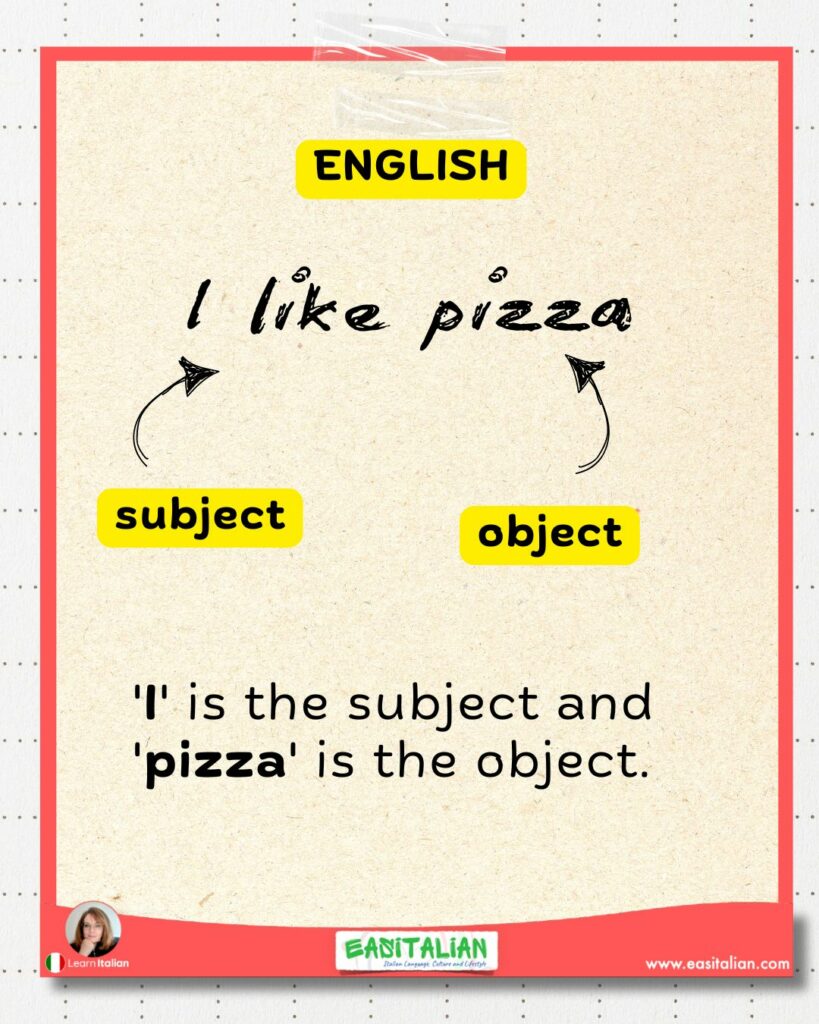
In Italian, the structure is flipped. The liked thing becomes the subject of conversation, while the liker becomes the indirect object.
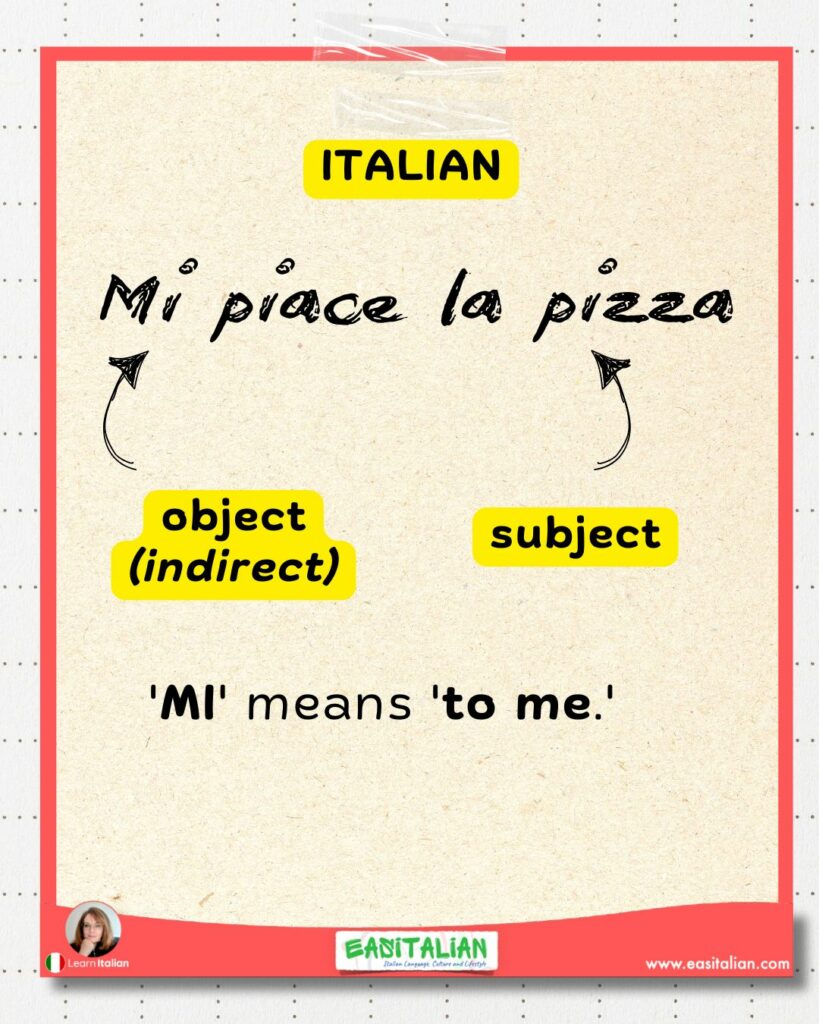
2. How Do You Conjugate “Piacere” in the Present Tense?
Conjugating “Piacere”
The verb “piacere” is unusual in Italian since it does not follow the same conjugation patterns as many other verbs. When conjugating “piacere” in the present tense, it changes depending on whether what is liked is singular or plural.
Present Tense Conjugation of “Piacere”
Here’s how “piacere” is used with different subjects in the present tense:
For single subjects:
- Mi piace (I like) -> singular noun or action
- Ti piace (You like) -> singular noun or action
- Gli/Le piace (He/She likes) -> singular noun or action
- Ci piace (We like) -> singular noun or action
- Vi piace (You all like) -> singular noun or action
- Gli piace (They like) -> singular noun or action
For plural subjects:
- Mi piacciono (I like) -> plural noun
- Ti piacciono (You like) -> plural noun
- Gli/Le piacciono (He/She likes) -> plural noun
- Ci piacciono (We like) -> plural noun
- Vi piacciono (You all like) -> plural noun
- Gli piacciono (They like)-> plural noun
Example Sentences:
Examples in the Present Tense
To better understand, let’s look at how “piacere” is used in different contexts:
Mi piace il gelato. (I like ice cream.)
Here, “piace” is used because “il gelato” (ice cream) is singular.
Ti piace leggere. (You like reading.)
“Piace” is used with the infinitive verb “leggere” (to read).
Le piacciono i film. (She likes movies.)
“Piacciono” is used because “i film” (movies) is plural.
Ci piacciono i concerti. (We like concerts.)
“Piacciono” is used because “i concerti” (concerts) is plural.
3. What’s the difference between “piace” and “piacciono“?
“Piacere” is most commonly used in the third person, either singular or plural, depending on what is liked:
- “Piace” is the third-person singular form.
- “Piacciono” is the third-person plural form.
Example:
- Mi piace la pizza. (I like pizza.)
- Mi piacciono le pizze. (I like pizzas.)
Mi piace il gelato. (I like the ice cream.)
Mi piacciono i gelati. (I like the ice creams.)
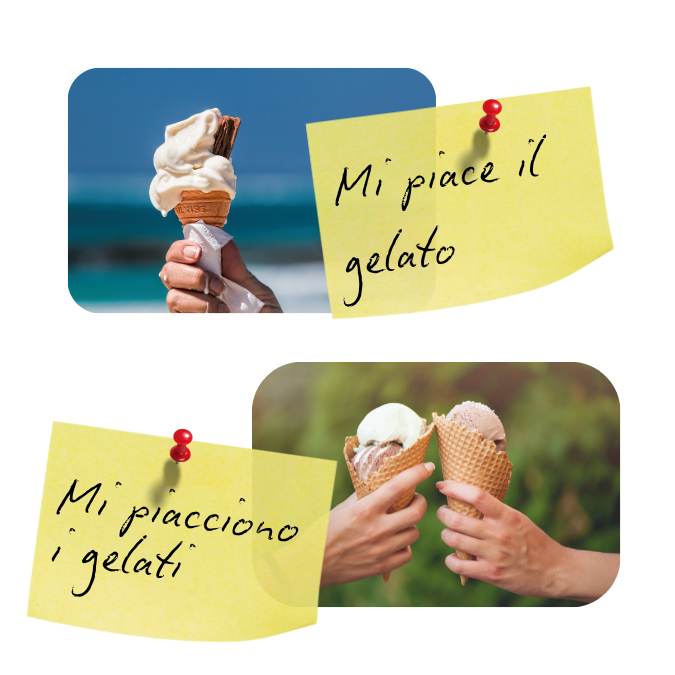
Gli piace il libro. (He likes the book.)
Gli piacciono i libri. (He likes the books.)
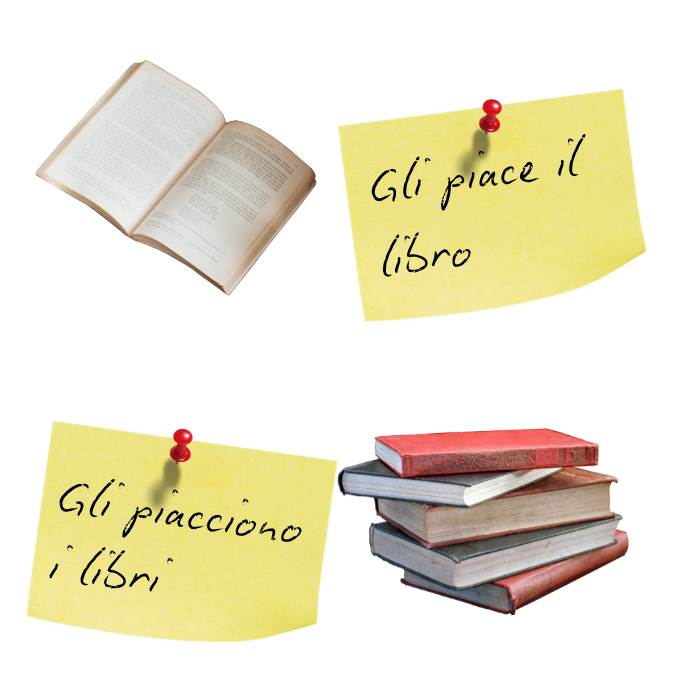
The form you use—“piace” or “piacciono”—depends on whether the noun that follows is singular or plural:
“Piace” is used when what is liked is singular or when followed by an infinitive verb (e.g., “Mi piace leggere” – “I like to read“).
“Piacciono” is used when what is liked is plural (e.g., “Mi piacciono i libri” – “I like books“).
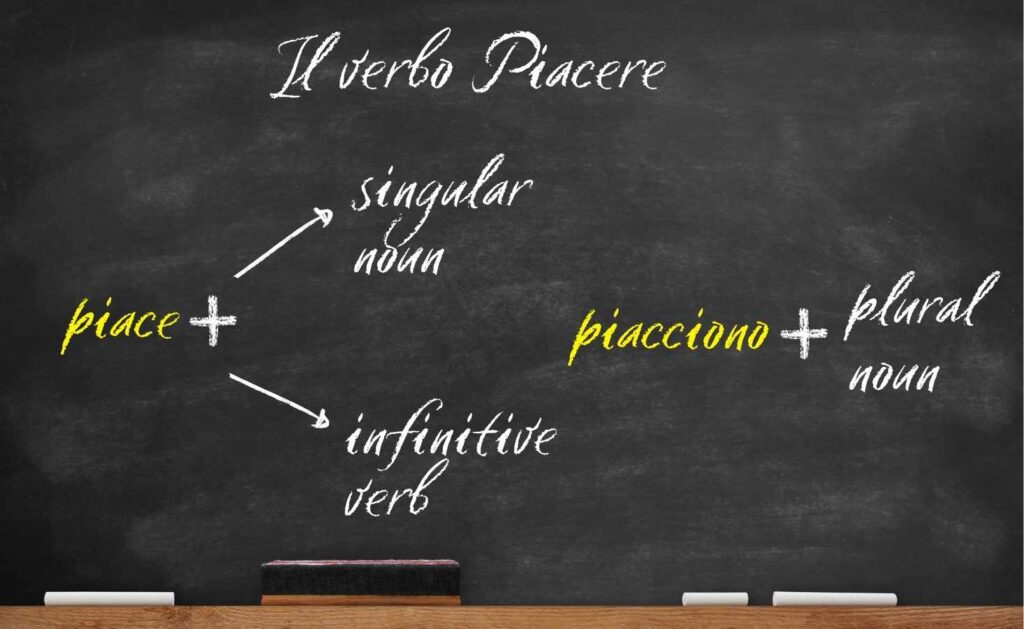
Examples:
Mi piace il gelato. (I like ice cream.) -> “Il gelato” is singular, so we use “piace.”
Ti piacciono le mele. (You like apples.) -> “Le mele” is plural, so we use “piacciono.”
Gli piace correre. (He likes running.) -> “Correre” (to run) is an infinitive verb, which is treated as singular, so we use “piace.”
Ci piacciono le montagne. (We like the mountains.) -> “Le montagne” is plural, so we use “piacciono.”
Vi piace la pizza. (You all like pizza.) -> “La pizza” is singular, so we use “piace.”
4. How do I conjugate “piacere” for different people?
“Piacere” conjugation depends on the indirect object pronoun and the subject of the sentence. To conjugate “piacere” correctly, match the verb to the subject (what is liked) in singular or plural form. The indirect object pronoun will change depending on who likes the thing.
1. Singular Forms:
When the thing is liked is singular or with an infinitive verb (like “leggere” – to read), we use “piace.”
1st person – Mi piace –> I like (to me it is pleasing)
Ex.: Mi piace il gelato. (I like ice cream.)
2nd person – Ti piace –> You like (informal singular)
Ex.: Ti piace la musica? (Do you like music?)
3rd person masculine – Gli piace –> He likes
Ex.: Gli piace la montagna. (He likes the mountain.)
3rd person feminine – Le piace –> She likes
Ex.: Le piace cucinare. (She likes to cook.)
4th person – Ci piace –> We like
Ex.: Ci piace il mare. (We like the sea.)
5th person – Vi piace –> You all like (plural)
Ex.: Vi piace la pizza? (Do you all like pizza?)
6th person – Gli piace –> They like
Ex.: Gli piace il calcio(They like soccer.)
2. Plural Forms:
When what is liked is plural, use “piacciono.”
1st person – Mi piacciono –> I like (plural things)
Ex.: Mi piacciono i libri. (I like books.)
2nd person – Ti piacciono –> You like (informal singular)
Ex.:Ti piacciono i fiori? (Do you like flowers?)
3rd person masculine – Gli piacciono –> He likes
Ex.: Gli piacciono le auto. (He likes cars.)
3rd person feminine – Le piacciono –> She likes
Ex.: Le piacciono le scarpe. (She likes shoes.)
4th person – Ci piacciono –> We like
Ex.: Ci piacciono gli animali. (We like animals.)
5th person – Vi piacciono –> You all like (plural)
Ex.:Vi piacciono i film d’avventura? (Do you all like adventure movies?)
6th person – Gli piacciono –> They like
Ex.:Gli piacciono i giochi. (They like games.)
Key Points to Remember:
Identify the Subject:
The subject of “piacere” is the thing or activity being liked, not the person who likes it. Make sure to identify if this subject is singular or plural to choose between “piace” or “piacciono.”
Use Indirect Object Pronouns:
Indirect object pronouns indicate who likes the subject. These pronouns (mi, ti, gli, le, ci, vi, gli) always precede “piacere.”
Conjugate According to the Subject:
If the subject is singular or an infinitive, use “piace.” If the subject is plural, use “piacciono.”
5. How do I say “I liked” in the past tense?
Using Passato Prossimo with “Piacere”
Passato prossimo is a compound tense used to indicate actions that occurred in the past.
To express this tense with “piacere,” use the auxiliary verb “essere” (to be) and the past participle “piaciuto”.
The auxiliary verb “essere” is conjugated based on the subject (the person who liked), but “piaciuto” is left unchanged.
The structure is:
Indirect Object PRONOUN + Auxiliary Verb (essere) + Past Participle (piaciuto)
Forming Passato Prossimo with “Piacere”:
- Mi è piaciuto (I liked) –> singular masculine noun or infinitive verb
- Mi è piaciuta (I liked) –> singular feminine noun
- Mi sono piaciuti (I liked) –> plural masculine nouns
- Mi sono piaciute (I liked) –> plural feminine nouns
Note: The past participle “piaciuto” changes its ending based on the gender and number of the noun or nouns that were liked.
For all other persons replace “mi” with the other indirect pronouns.
Examples:
Mi è piaciuto il film. (I liked the movie.)
Il film (the movie) is singular and masculine, so we use “è piaciuto.“
Mi è piaciuta la pizza. (I liked the pizza.)
La pizza (the pizza) is singular and feminine, so we use “è piaciuta.“
Mi sono piaciuti i libri. (I liked the books.)
I libri (the books) are plural and masculine, so we use “sono piaciuti.”
Mi sono piaciute le canzoni. (I liked the songs.)
Le canzoni (the songs) are plural and feminine, so we use “sono piaciute.”
Understanding the Context
- Singular Nouns or Infinitive Verbs: When expressing that you liked a singular noun or an infinitive verb, use “è piaciuto” or “è piaciuta,” depending on the noun’s gender.
- Plural Nouns: For multiple things that you liked, use “sono piaciuti” or “sono piaciute,” based on the gender of the items.
Common Mistakes to Avoid
Confusing Gender and Number:
Ensure the past participle agrees with the noun’s gender and number. For instance, do not use “piaciuto” for feminine plural nouns or “piaciuti” for singular nouns.
Incorrect Auxiliary Verb:
Always use “essere” with “piacere” in passato prossimo. Using “avere” would be incorrect.
Forgetting Agreement:
Remember that “piaciuto” or “piaciuta” must agree with the subject of the sentence in gender and number.
6. Can “piacere” be used with infinitive verbs?
Yes, “piacere” can be used with infinitive verbs, and it is commonly used in Italian to express likes and preferences for activities or actions.
Understanding how to use “piacere” with infinitive verbs is essential if you’re learning Italian and want to talk about actions you enjoy.
Understanding “Piacere” and Infinitive Verbs
In Italian, you use the verb “piacere” followed by an infinitive verb to express how much you enjoy doing something. An infinitive verb is the primordial form of a verb, such as “mangiare” (to eat), “leggere” (to read), or “correre” (to run).
When you use “piacere” with an infinitive verb, the construction remains singular, regardless of how many actions you’re talking about. Because the infinitive verb is considered a singular noun phrase, “piacere” will always get the third-person singular form “piace”.
How to Construct Sentences with “Piacere” and Infinitive Verbs
To form sentences using “piacere” with an infinitive verb, follow this structure:
Indirect Object Pronoun + “piace” + Infinitive Verb
Indirect Object Pronoun: This tells us to whom something is pleasing (i.e., who likes the action). The pronouns used are:
- mi (to me)
- ti (to you, informal)
- gli (to him)
- le (to her)
- ci (to us)
- vi (to you all)
- gli (to them)
+ “Piace”: The third person singular form of “piacere,” used with all infinitive verbs.
+ Infinitive Verb: This is the activity that is liked, such as “mangiare” (to eat), “viaggiare” (to travel), or “dormire” (to sleep).
Examples of “Piacere” with Infinitive Verbs
Here are some examples of sentences using “piacere” with infinitive verbs:
Mi piace leggere. (I like to read.)
Leggere (to read) is the action liked by “me,” hence “mi piace.”
Ti piace cucinare? (Do you like to cook?)
Cucinare (to cook) is the action liked by “you,” hence “ti piace.”
Gli piace nuotare al mattino.(He likes to swim in the morning.)
Nuotare (to swim) is the action liked by “him,” hence “gli piace.”
Ci piace viaggiare durante l’estate. (We like to travel during the summer.)
Viaggiare (to travel) is the action liked by “us,” hence “ci piace.”
Vi piace andare al cinema? (Do you all like to go to the movies?)
Andare (to go) is the action liked by “you all,” hence “vi piace.”
Gli piace ballare e cantare. (They like to dance and sing.)
Even though two actions are mentioned (“ballare” and “cantare”), the verb “piacere” remains in the singular form “piace” because each action is treated individually.
Key Points to Remember:
Always Use “Piace”: When using “piacere” with an infinitive verb, always use the singular form “piace.” This does not change regardless of the number of infinitive verbs listed.
Agreement with the Indirect Object Pronoun: Make sure to use the correct indirect object pronoun to indicate who likes the action. This pronoun must match the person enjoying the activity.
Infinitive Verbs are Treated as Singular: The infinitive verb does not affect the number of the verb “piacere.” It’s always considered singular.
Common Mistakes to Avoid:
Using “Piacciono” with Infinitives: Don’t use the plural “piacciono” when listing multiple activities. Even if you like doing several things, “piacere” stays singular when followed by infinitives.
Incorrect Indirect Object Pronouns: Ensure that the indirect object pronoun correctly reflects the person who likes the activity. “Gli piace” means “he likes” and “Gli piace” means “they like.”
Confusing Infinitive with Conjugated Verbs: Remember that the verb following “piace” must always be in the infinitive form when expressing a liked activity. For example, “Mi piace nuotare,” not “Mi piace nuoto.”
7. How do I say “I would like” using “piacere“?
Learning how to communicate needs and make polite requests is an important part of mastering any language. One of the most common ways to say “I would like” in Italian is to use the conditional tense of the verb “piacere”. This form is useful for expressing wishes, making polite requests, and describing what you would like to do in specific situations.
Understanding “piacere” in the conditional tense
When you express “I would like” in Italian with “piacere,” you use the conditional tense. The conditional tense is used to indicate what someone desires to achieve in particular circumstances or to make polite requests.
In English, saying “I would like” is a kinder and more polite way of saying “I want.” Similarly, in Italian, “mi piacerebbe” is a polite way of expressing a desire or preference.
How to Form the Conditional of “Piacere”
To form the conditional tense of “piacere,” you use the following structure:
Indirect Object Pronoun + “piacerebbe” (singular) / “piacerebbero” (plural)
The indirect object pronouns remain the same as in other tenses:
- Mi (to me)
- Ti (to you, informal)
- Gli (to him)
- Le (to her)
- Ci (to us)
- Vi (to you all)
- Gli (to them)
Using “Piacerebbe” and “Piacerebbero”
“Piacerebbe”: Use this form when referring to a singular noun or an infinitive verb. It means “would like” or “would be pleasing to” in a singular sense.
Example: Mi piacerebbe un caffè. (I would like a coffee.)
Example: Mi piacerebbe viaggiare. (I would like to travel.)
“Piacerebbero”: Use this form when referring to plural nouns. It means “would like” or “would be pleasing to” in a plural sense.
Example: Mi piacerebbero due biscotti. (I would like two cookies.)
Example: Ti piacerebbero questi libri? (Would you like these books?)
Examples of “Piacere” in the Conditional Tense
Here are some examples to illustrate how to use “piacere” in the conditional tense:
Mi piacerebbe visitare Roma. (I would like to visit Rome.)
Here, “mi piacerebbe” is used with the infinitive verb “visitare.”
Le piacerebbe un tè? (Would she like a tea?)
Le piacerebbe is used to politely ask if someone would like something.
Ci piacerebbe provare la cucina italiana. (We would like to try Italian cuisine.)
Ci piacerebbe is paired with the infinitive verb “provare.”
Vi piacerebbero i musei? (Would you all like the museums?)
Vi piacerebbero is used here to ask about a plural noun, “musei.”
Gli piacerebbe avere una casa al mare. (He would like to have a house by the sea.)
Gli piacerebbe is used with the infinitive “avere” to express a desire.
Key Points to Remember:
Indirect Object Pronouns are Essential: Always pair “piacerebbe” or “piacerebbero” with the appropriate indirect object pronoun to indicate who would like something.
“Piacerebbe” vs. “Piacerebbero”: Use “piacerebbe” for singular nouns and infinitive verbs, and “piacerebbero” for plural nouns.
Politeness and Softness: Using “piacere” in the conditional tense is a polite way to make requests or express desires, similar to saying “I would like” in English.
Context Matters:
The choice between “piacerebbe” and “piacerebbero” depends on the number (singular or plural) of the noun or activity being referred to.
Common Mistakes to Avoid:
Confusing Singular and Plural Forms: Don’t use “piacerebbero” with singular nouns or “piacerebbe” with plural nouns. Make sure the verb agrees with the noun or infinitive verb correctly.
Incorrect Indirect Object Pronouns: Make sure the indirect object pronoun matches the person expressing the desire. For example, “mi” for “I,” “ti” for “you,” “gli” for “he/they,” etc.
8. How do I negate a sentence with “piacere“?
Learning how to negate sentences in Italian is a key aspect of being fluent in the language. When it comes to negating the verb “piacere,” there are a few rules to follow to make sure your phrases are grammatically correct.
The Basics of Negating “Piacere”
To negate a sentence with “piacere,” you simply place the word “non” before the verb.
This rule works no matter the tenses or forms of “piacere” you are using.
The structure for negating a “piacere” sentence is:
Non + [indirect object pronoun] + piace/piacciono/piacerebbe/piacerebbero + [noun/infinitive verb]
Non: This is the word used to negate the sentence. It is always placed directly before the pronoun and the verb “piacere.”
Indirect Object Pronoun: This indicates to whom something is not pleasing. It changes depending on the person:
- mi (to me)
- ti (to you, informal)
- gli (to him)
- le (to her)
- ci (to us)
- vi (to you all)
- gli (to them)
Piace/Piacciono/Piacerebbe/Piacerebbero: These are different forms of “piacere” used depending on the tense, number, and person. When negating, this verb form does not change except for agreement in number and tense as usual.
Examples of Negating “Piacere”
Here are some examples to illustrate how to negate “piacere” in different contexts:
Present Tense:
Non mi piace il gelato. (I do not like ice cream.)
“Non” negates the sentence, indicating that ice cream is not pleasing to me.
Non ti piacciono le verdure? (Don’t you like vegetables?)
Here, “non” is placed before “ti” and “piacciono” to negate liking vegetables.
Conditional Tense:
Non ci piacerebbe andare al cinema. (We would not like to go to the cinema.)
“Non” is used to express that going to the cinema would not be pleasing to us.
Non gli piacerebbero questi film. (They would not like these movies.)
“Non” negates the conditional form “piacerebbero,” meaning the movies would not be pleasing to them.
Past Tense:
Non le è piaciuto il libro. (She did not like the book.)
“Non” is placed before “le è piaciuto,” indicating that the book was not pleasing to her in the past.
Non mi sono piaciute le canzoni. (I did not like the songs.)
Here, “non” is placed before “mi sono piaciute” to negate the liking of the songs in the past.
Negating “Piacere” with Infinitive Verbs
When “piacere” is followed by an infinitive verb, the negation still follows the same rule: place “non” before the form of “piacere.” –> (pronoun+verb piacere)
Non mi piace correre. (I do not like to run.)
“Non” negates the enjoyment of the activity “correre” (to run).
Non ti piacerebbe viaggiare?(Wouldn’t you like to travel?)
“Non” is used here to negate the desire to travel in a polite request.
Key Points to Remember:
Always Use “Non” Before “Piacere”:
When negating a sentence with “piacere,” “non” should always precede the form of the verb “piacere” (pronoun+verb piacere) regardless of tense or number.
Match the Verb to the Subject:
While “non” negates the sentence, make sure that “piacere” is correctly conjugated according to the subject (what is liked or not liked) and the indirect object pronoun (who likes or doesn’t like it).
Consistency Across Tenses:
The placement of “non” remains consistent across all tenses and forms. If you are using the present, past, or conditional tense, “non” comes directly before the “piacere” verb form. –> (pronoun+verb piacere)
Common Mistakes to Avoid:
Placing “Non” in the Wrong Position: Ensure that “non” is always placed immediately before the form of the verb “piacere” (pronoun+verb piacere) and not after the verb.
Incorrect Verb Form Agreement: While negating, remember that the verb form (piace/piacciono, etc.) must still agree with the noun it refers to, even if it is negated.
Double Negatives: Avoid using double negatives like “non” with other negative words (like “mai” without proper structure), as they can create confusion.
Conclusion
In conclusion, it is essential to master the verb “piacere” for expressing likes and dislikes in Italian.
Although the structure may differ from what you are used to in English, it becomes straightforward once you grasp the basics.
Remember that the person who likes something is the indirect object, while the thing they like is the subject.
By following the rules for conjugating “piace” and “piacciono,” and knowing where to place “non” for negation, you will be able to explain your choices confidently. With a little practice, using “piacere” will become second nature!

What’s next?
You might want to keep learning Italian online with these free resources:








Mark Newton
Grazie mille! Una eccellente lezione! But my query is, under “Common Mistakes to Avoid:
Placing “Non” in the Wrong Position: Ensure that “non” is always placed immediately before “piacere” and not before the indirect object pronoun or after the verb.
Yet, in the examples, the Non is placed before the indirect object pronoun. Is this simply a mistake in the text?
Ciao, Mark Newton, Melbourne
easitalian
Ciao Mark,
Thank you so much for taking the time to point out the problem in the page! You’re absolutely right — there was indeed a mistake in the text, for some reason.
The correct placement of “non” should be before the verb piacere or any indirect object pronoun, as you rightly observed. I’ll make sure to correct that in the text trying to make it as clear as possible.
Thanks again for your feedback, and I hope you continue to enjoy the website!
Best regards,
Anna for Easitalian.com